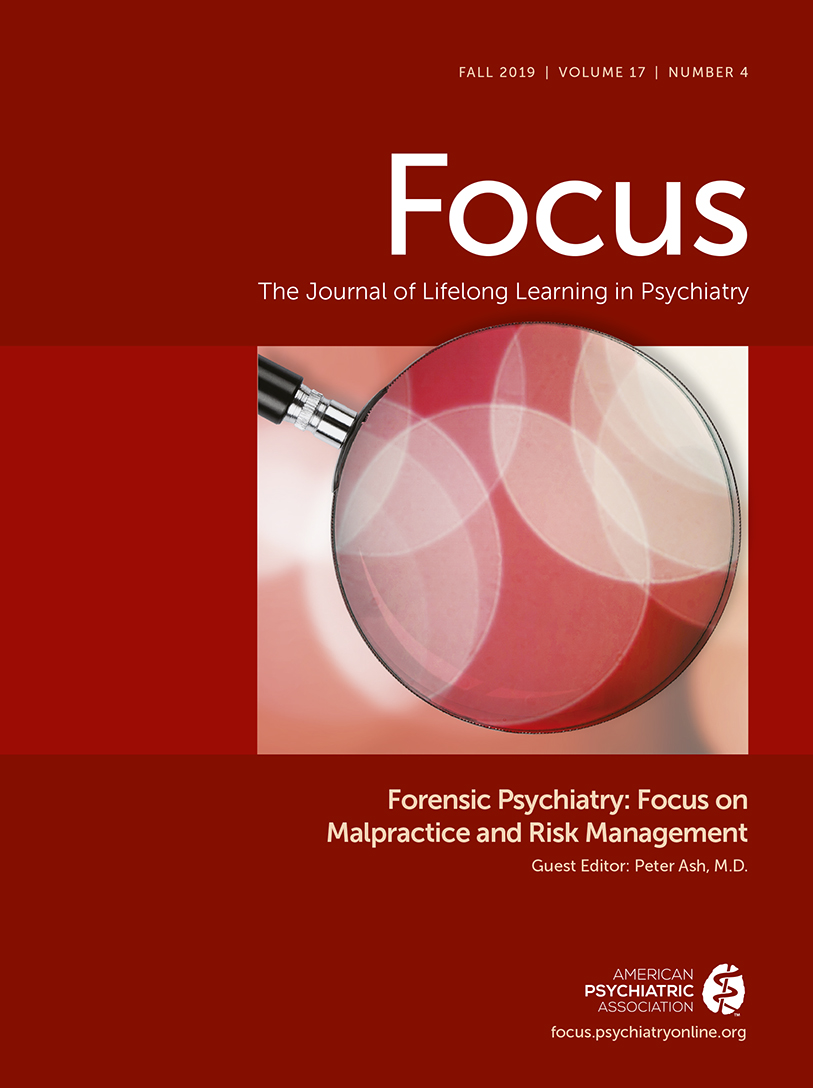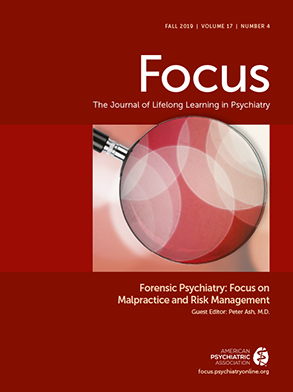Agency referrals
A formal, independent psychiatric examination may be requested when problematic behavior raises questions about a physician’s fitness to practice. Usually, the observations and concerns about the physician’s conduct will have been reported to an agency responsible for oversight of physicians, such as a hospital administrative committee or department chair, a hospital physician health committee, a state physician health committee, or a state licensing board. Any of these agencies is statutorily mandated (
139) to intervene in the presence of reasonable concerns and order a physician to undergo an assessment (
18,
140–
142). A request for an IME may also originate from the physician who is the subject of a peer review or administrative law investigation, or from an attorney representing a defendant physician (
49).
The evaluator will be asked to perform a comprehensive evaluation of the physician and provide a full report of the findings. Psychiatrists who conduct physician FFD evaluations should consider how a psychiatric condition, a medical condition, or a medication side effect might affect the evaluee’s ability to practice his or her specific specialty. Evaluators will also be asked to offer opinions about past professional conduct, current health, and future capacity to function safely as a physician. The evaluator is likely to be asked for recommendations about treatment and professional supervision or oversight if indicated (
19,
49,
140).
Physicians are often referred for evaluation absent any known direct patient harm. The conduct in question may have occurred outside of the workplace. Justifying the need for such referral is the state board’s concern that, when a physician’s health or wellness is compromised, the safety and effectiveness of medical care may also be compromised (
143). The AMA defines physician impairment as “the inability to practice medicine with reasonable skill and safety as a result of illness or injury.” The definition encompasses impairment related to psychiatric disorder, substance use, dementia, other medical disorders or medicines with cognitive or behavioral side effects.
Physician FFD evaluations are also frequently requested to evaluate troublesome or disruptive behavior (
140,
144,
145). The AMA defines disruptive behavior as “conduct, whether verbal or physical, that negatively affects or that potentially may negatively affect patient care (
146).” This includes, but is not limited to, conduct that interferes with the ability to work with other members of the health team.
Disruptive physicians may engage in a range of unprofessional actions. Examples include displays of inappropriate anger, intimidation of coworkers, unwillingness to take responsibility for adverse events, and failure to fulfill professional responsibilities (e.g., repeated failure to respond to calls) (
49,
147). Physicians may also be referred for evaluation because of accusations of sexual harassment, other boundary violations, or an arrest (
19,
49,
140). Disruptive or illegal behavior may or may not be caused by a major psychiatric disorder, but could reflect longstanding problematic maladaptive personality traits or a personality disorder (
19,
140,
144,
147).
The ability of a physician to practice safely may be compromised by factors unrelated to psychiatric impairment, such as deficient knowledge, skill, or experience. The task of assessing physicians’ technical competence in their specialty is outside the scope of FFD evaluations (
19). If an evaluating psychiatrist suspects that incompetent skills could be a factor in impaired performance, the evaluee should be referred for further assessment. In such cases, a state medical society physician competency committee can act as a resource (
49). Evaluators should consider noting in their reports that their expressed opinions are limited to assessment of the relevant psychiatric factors (
140,
145).
All referral sources will ask for an opinion about the fitness to practice medicine (
142,
145). However, more specific referral questions are generated by the focus, mission, concerns, or agendas of referring agencies. For example, when a hospital department, group practice, or an administrative board refers a physician for assessment, they may be concerned about the safety of the workplace and the physician’s ability to meet the institution’s expectations for acceptable conduct. Often there are written policies that describe these expectations. FFD examinations requested by residency training programs or medical schools may reflect concerns about fitness to complete training and fitness for learning. Referral questions from military and Department of Defense agencies may reflect features of their specific codes of conduct (
140,
145).
Psychiatrists providing physician FFD evaluations should be familiar with the objectives of each of the agencies that monitor physician conduct, given that these are frequent sources of physician FFD referrals. These agencies include:
1.
hospital-based physician health committees (
49,
148,
149);
2.
state physician health programs that operate independent of the state medical licensing board and are not involved in the disciplinary process; and state medical licensing boards (
19,
49,
140,
150).
Physician health programs at both the state and hospital level are primarily interested in physician health and the preservation, if possible, of a physician’s ability to practice safely. Their referral questions will center on the identification of psychiatric disorders that affect the physician’s ability to practice. In addition to major psychiatric disorders and personality disorders, a physician health program would be concerned about personality traits or stressors (e.g., divorce or other personal or family problem) that may help to explain the reported misconduct 19,49,140,150.
Physician health programs often ask for opinions that go beyond diagnosis of psychiatric disorder. If a treatable disorder is identified, the physician health program will ask for suggestions for treatment and for monitoring compliance. The physician health program will ask psychiatric evaluators for opinions about the need for oversight in the work environment. If the evaluator believes that the physician cannot safely continue to work, there will be further questions about a strategy for rehabilitation. Many physician health programs have a standard contract that is modified based on the evaluator’s recommendations. If the physician fails to complete the contract or violates one of the provisions of the contract, then the state medical board may be notified (
49,
140,
150).
In contrast to a physician health program, a state medical licensing board is primarily concerned with protecting the public, and the referral questions generated by state licensing boards reflect this mandate. State boards have the authority to order FFD evaluations under a variety of circumstances in which they consider public safety to be at stake. During the licensing process, a physician may disclose information that raises questions about current fitness or need for monitoring (for example, if the physician was under a monitoring agreement in another state).The enforcement division of the state medical licensing board may request an evaluation after a complaint from a patient, a colleague, or a health care agency, or after an arrest. The costs for such evaluations are generally borne by the physician rather than the board.
The results of the FFD evaluation can affect a board’s decision to grant licensure. A license to practice medicine is a privilege that is regulated by medical boards (
19,
140,
145). A license can be suspended or revoked after an administrative hearing. Although there are provisions for appeals to civil courts, state medical licensing boards are afforded wide authority and discretion to protect the public. State medical licensing boards provide physician defendants with certain legal rights, such as the right to cross-examine witnesses and the right to present evidence. However, the protections available to physician defendants are substantially narrower than those afforded to criminal or civil defendants (
140).
The state medical licensing board may decide to divert the physician to the state physician health committee. The state licensing board may also decide to discipline the physician, an action that can have lasting professional consequences. Official disciplinary actions such as public reprimand, suspension, and revocation may be reported to the National Practitioner Data Bank. States vary in the degree of public disclosure of complaints, investigations, findings, and actions (
19). Nevertheless, this information has increasingly become readily available online in the form of physician profiles (
141,
151).
The evaluation
The APA has developed a resource document on guidelines for psychiatric fitness-for-duty evaluations for physicians (
19). These guidelines recommend conducting a thorough psychiatric assessment, obtaining a detailed history, collecting collateral information (including indices of past performance), and ordering psychological testing as indicated. Questions about previous peer review allegations, disciplinary actions, malpractice history, and prior complaints to the state board or hospital committees can provide important information related to performance. When there are allegations of a professional boundary violation, a detailed sexual history should be obtained.
Psychiatric evaluators should offer opinions about the presence of a mental illness and the extent, if any, to which the mental illness has interfered with the evaluee’s ability to practice with skill and safety in the specific work setting. The evaluator should provide a description of how the mental illness affects job-related capacities and thus fitness for duty (
19,
49). These opinions should be supported by specific data obtained from the evaluation of the physician and information collected from collateral sources. Physician FFD evaluations also require an assessment of short- and long-term risk arising from a diagnosed mental disorder and suggestions for risk management and mitigation.
Some evaluators incorporate tests of frontal lobe function as part of the mental status examination to screen for deficiencies of memory, language, judgment, and executive function. The administration of a full neuropsychological battery may be needed if cognitive impairment is suspected. When a substance use disorder is suspected, appropriate serum, urine, and hair analyses can be obtained by the referring agency (
19). If indicated, the evaluee should be referred for a medical evaluation and for appropriate laboratory and imaging studies.
Evaluators usually provide specific recommendations for treatment, including modality, duration, and frequency. Evaluators may provide recommendations of the monitoring, scope of practice activities, and supervision of the evaluee’s clinical activities. Often an evaluee will have a workplace supervisor-monitor who, like the evaluee’s treating clinicians, will document the evaluee’s adherence with treatment and workplace recommendations. Evaluees with substance use disorders may need mandated random urine screening to document abstinence. The evaluator’s recommendations are often incorporated into a consent decree or contract between the state board or state physician health service and the evaluee (
49,
140,
145).
Evaluators are often asked for opinions about the prognosis of the diagnosed disorder, the risk of relapse, and risk mitigation. Identification of observable premonitory signs of relapse is particularly helpful for both the treating clinicians and the workplace monitors. An understanding of the evaluee’s long-term vulnerabilities will help the evaluee’s monitors and supervisors intervene promptly when necessary. The evaluator may suggest specific administrative and therapeutic steps with which workplace monitors can respond if the evaluee relapses (
140,
145).
Opinions should be well supported by data, and the foundation for opinions should be discussed in detail in the report. Evaluators should also comment about an evaluee’s customary interpersonal style (
144). The evaluee’s capacity for conscious awareness of psychological and behavioral problems and openness to treatment and supervision are both essential findings for developing a plan of oversight (
140,
145).
The state medical licensing boards expect a report that allows for the board personnel themselves to review the basis of the evaluator’s opinion. The APA Guidelines recommend that sensitive personal information be omitted or summarized in a report for the medical licensing board when it does not directly bear on the referral concerns (
19). It may be appropriate to edit personal information when reporting to practice groups, hospitals, or HMOs where the recipients of the report often personally know or have potential conflicts of interest with the evaluee. If the information is withheld, the report should document that the sensitive information (personal, medical, or social) was obtained and considered (
19,
49).

